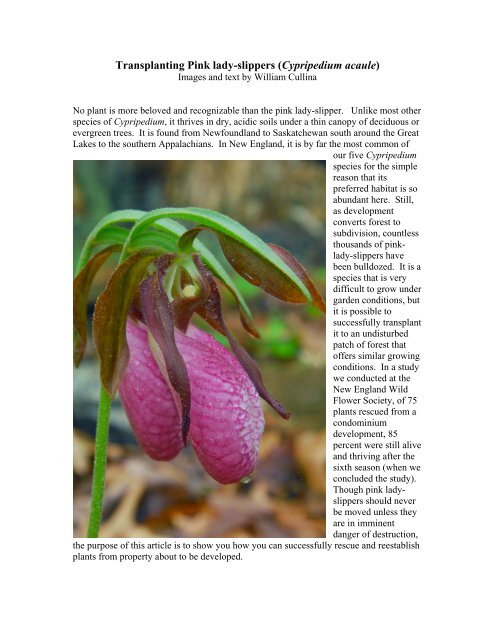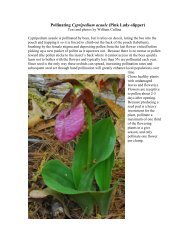Transplanting Pink lady-slipper (Cypripedium acaule) - William Cullina
Transplanting Pink lady-slipper (Cypripedium acaule) - William Cullina
Transplanting Pink lady-slipper (Cypripedium acaule) - William Cullina
You also want an ePaper? Increase the reach of your titles
YUMPU automatically turns print PDFs into web optimized ePapers that Google loves.
<strong>Transplanting</strong> <strong>Pink</strong> <strong>lady</strong>-<strong>slipper</strong>s (<strong>Cypripedium</strong> <strong>acaule</strong>)<br />
Images and text by <strong>William</strong> <strong>Cullina</strong><br />
No plant is more beloved and recognizable than the pink <strong>lady</strong>-<strong>slipper</strong>. Unlike most other<br />
species of <strong>Cypripedium</strong>, it thrives in dry, acidic soils under a thin canopy of deciduous or<br />
evergreen trees. It is found from Newfoundland to Saskatchewan south around the Great<br />
Lakes to the southern Appalachians. In New England, it is by far the most common of<br />
our five <strong>Cypripedium</strong><br />
species for the simple<br />
reason that its<br />
preferred habitat is so<br />
abundant here. Still,<br />
as development<br />
converts forest to<br />
subdivision, countless<br />
thousands of pink<strong>lady</strong>-<strong>slipper</strong>s<br />
have<br />
been bulldozed. It is a<br />
species that is very<br />
difficult to grow under<br />
garden conditions, but<br />
it is possible to<br />
successfully transplant<br />
it to an undisturbed<br />
patch of forest that<br />
offers similar growing<br />
conditions. In a study<br />
we conducted at the<br />
New England Wild<br />
Flower Society, of 75<br />
plants rescued from a<br />
condominium<br />
development, 85<br />
percent were still alive<br />
and thriving after the<br />
sixth season (when we<br />
concluded the study).<br />
Though pink <strong>lady</strong><strong>slipper</strong>s<br />
should never<br />
be moved unless they<br />
are in imminent<br />
danger of destruction,<br />
the purpose of this article is to show you how you can successfully rescue and reestablish<br />
plants from property about to be developed.
It is well known that all orchids have evolved a very sophisticated strategy for seed<br />
germination. Orchid seeds are tiny and lack well developed embryos. To germinate, the<br />
seed must come in contact with a<br />
specific soil fungus which<br />
surrounds the seed as if to digest it.<br />
The fungal roots (hyphae)<br />
penetrate the seed and then the<br />
orchid turns the tide, digesting the<br />
fungus instead. It seems that the<br />
fungus gets nothing from this<br />
arrangement except to be eaten, so<br />
rather than the symbiotic<br />
relationship found with most<br />
mychorrizal interactions, in this<br />
case the union is more properly<br />
called micoparisitism. After 3-4<br />
years in the soil growing larger at<br />
the expense of the fungus, the seeding emerges and begins to photosynthesize for its<br />
food. At this point, it is unclear how important the<br />
fungus becomes to the more mature <strong>lady</strong>-<strong>slipper</strong>.<br />
Mature plants can remain underground for several<br />
years after a bad drought, predation, or other<br />
trauma, so it does appear that some continued<br />
relationship is important to the health of the plant.<br />
One plant that I moved in 1990 grew for a few<br />
years then disappeared, only to appear and bloom<br />
again in 2005 then disappear in 2006 and reappear<br />
in 2007 as a two-leaved but non-flowering plant!<br />
Just how widespread the proper group of fungi is<br />
through the range of the orchid is unclear, but<br />
absence of plants in apparently suitable habitat<br />
does not necessarily mean there is no fungus<br />
present. The most important consideration when<br />
choosing a spot for relocation is the pH of the soil,<br />
the available light, and potential competition from<br />
other plants. The pH of the soil is important<br />
because unless the soil is extremely acidic, C. <strong>acaule</strong> is prone to attack by root diseases<br />
that are naturally suppressed at low pH. Soils with a pH below 5.0 are optimal. You can<br />
test the soil with inexpensive pH test kits or look for indicator plants that like a similar<br />
habitat (obviously, if pink <strong>lady</strong>-<strong>slipper</strong>s grow there already, it is ideal). In our area of<br />
southern New England as well as most parts of Central and Northern New England, the<br />
soils are considered to be very acidic. Pines, oaks, hickories, spruce, fir, and paper birch<br />
are common canopy species in pink <strong>lady</strong>-<strong>slipper</strong> habitat. Some indicator plants to for at<br />
ground level include:
Dendrolycopodium dendroideum Chimaphila maculata Gautheria procumbens<br />
(and other clubmosses) (spotted wintergreen) (wintergreen, checkerberry)<br />
Vaccinium angustifolium Gaylussacia baccata Kalmia angustifolia<br />
(lowbush blueberry and (black huckleberry) (sheep laurel)<br />
other blueberries)<br />
<strong>Pink</strong> <strong>lady</strong>-<strong>slipper</strong>s do poorly in deep shade, and this is the most common reason they<br />
disappear over time from a given woods. They are most abundant in either very old<br />
forests with a mixed and broken canopy or in young forest regenerating after logging or<br />
fire. Road cuts and other edge habitats are also good places to find them. I look for<br />
places where the tree canopy has some gaps from windfalls or timber harvest to site
plants rather than in total shade under a continuous canopy.<br />
This is especially important under evergreens. Look for places where the sun breaks<br />
through for an hour or so each day.<br />
Chose areas where the ground is reasonably free of competition. Here huckleberries,<br />
wintergreen, mountain laurel (Kalmia latifolia) and a small white pine indicate good<br />
habitat. I will site the plant just in front of the dead branch in the center.
Though in an emergency, you can successfully move pink <strong>lady</strong>-<strong>slipper</strong>s at any time<br />
during the growing season, I have had the best results when I moved them in late summer<br />
just as the leaves begin to yellow. This plant flowered earlier in the season, but deer<br />
nipped of the bloom stalk. C. <strong>acaule</strong>’s roots are very shallow and spread out from the<br />
crown 8-24 inches in all directions, so care must be taken to damage them as little as<br />
possible.<br />
I use a pitchfork to lift the roots gently, coming in<br />
at a shallow angle about 12 inches from the crown<br />
and rocking the fork until the crown lifts up. At<br />
this point I use my hands to help tease the roots free from tree roots and debris. Here the<br />
plant has been lifted with little breakage of the roots and with some humus still<br />
surrounding them.
You can also<br />
remove plants<br />
bare-root as<br />
long as you have<br />
damp burlap to<br />
cover them with<br />
until them are<br />
replanted. This<br />
smaller<br />
individual<br />
has<br />
one welldeveloped<br />
bud<br />
visible in the<br />
center of the<br />
image and a<br />
moderately<br />
sized root<br />
system.<br />
Blackened roots<br />
are stained by humic acids in the soil but still healthy. The white roots are younger.<br />
Lady-<strong>slipper</strong><br />
roots will<br />
continue to live<br />
and grow longer<br />
over the course<br />
of about 5 years.<br />
However, if the<br />
growing tip is<br />
damaged on a<br />
particular root, it<br />
cannot grow<br />
another. In this<br />
image, the<br />
healthy white<br />
root began<br />
growing this<br />
spring (after<br />
flowering) as<br />
did the slightly<br />
more stained<br />
one at the left. Notice that this second root has lost its tip and can grow no<br />
longer.<br />
The<br />
roots are all important to <strong>lady</strong>-<strong>slipper</strong>s as they not only take up water and nutrients<br />
(and perhaps carbohydrates from the fungus) but they also act as the primary foodstorage<br />
organ for the plant during dormancy. If roots are cut or damaged during
transplant, they will stop growing and be vulnerable to infection. The loss of more than a<br />
few can spell disaster for the plant, as it has lost a good share of its food reserves and will<br />
likely wither away over the next year or two. This is a common occurrence in gardens,<br />
where a rescued or wild-collected plant will come up the first year, come back smaller the<br />
next, and fail to return the third. C. <strong>acaule</strong>’s roots inhabit what is called the F horizon in<br />
the soil. This<br />
is the zone or<br />
layer just<br />
underneath the<br />
unrotted leaves<br />
and other<br />
debris in this<br />
image. A few<br />
roots may pass<br />
through the<br />
narrow H<br />
horizon and<br />
into the black<br />
and gray A<br />
horizon. The<br />
H horizon is<br />
not topsoil, but<br />
rather a porous<br />
blend of<br />
partially<br />
decomposed<br />
organic<br />
materials.<br />
When<br />
replanting the<br />
orchid, it is<br />
essential that<br />
you relocate<br />
the roots in<br />
this layer as<br />
they will<br />
often<br />
rot if buried in<br />
the heavier<br />
horizons<br />
beneath.
I use a digging spade to scrape away the H horizon,<br />
exposing but no removing the lighter A horizon beneath.
Set the plant into this shallow hole and use your fingers to pack the duffy humus<br />
(H horizon) you just scraped off<br />
around the root mass (if the plant is<br />
bare-root, be extra careful to work the<br />
material in, around and between the<br />
roots so as they are spread out).
In this image, a bare-root plant has been set at the proper depth and is ready to be<br />
repacked with duff.<br />
Set the plant so that the tip of the white, pointed bud evident in this image lies just below<br />
the surface when you are finished.
The finished plant with<br />
unrotted leaves spread<br />
back over the roots once<br />
they have been backfilled<br />
with duff. By choosing a<br />
suitable spot, disturbing<br />
the soil horizons as little<br />
as possible and locating<br />
the roots at the proper<br />
depth, I have maximized<br />
this plant’s chances for<br />
success. Other than a<br />
good watering or two to<br />
settle the soil, no<br />
additional water or<br />
supplements are needed.<br />
The same plant the following spring with healthy leaves but no flowers. They are stiff<br />
and just pale enough to let me know they are receiving enough light.
Again, the same plant in its second spring, now with two growths and a beautiful bloom –<br />
both signs that it is settled in and thriving! Notice how the wintergreen in the first picture<br />
has spread beyond the dead branch and around the plant as it heads toward the light.<br />
Good Luck!<br />
©<br />
2007 <strong>William</strong> <strong>Cullina</strong>




